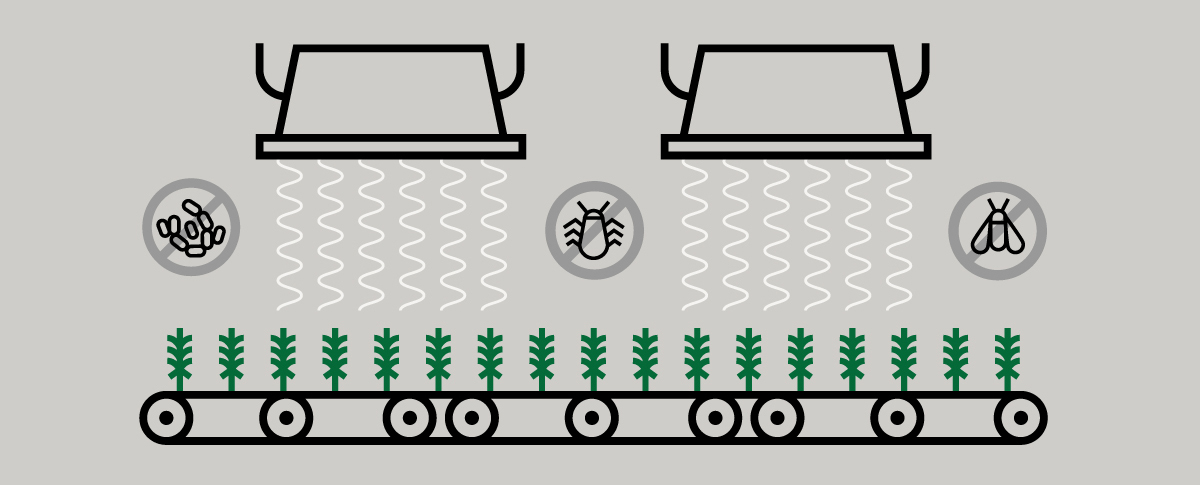What you need to know on
Cannabis irradiation
Cannabis production is a complex activity. Even though authorized cannabis producers have quite the green thumb, there exist a thousand different components that can, at any moment, potentially threaten the integrity and quality of the product, such as bacteria, mould, and yeast, to name but a few.
So, how can we ensure that products maintain their quality and specific characteristics? With a widely used but little-known process called irradiation, that’s how.

What is irradiation?
Irradiation is the process of exposing a product to rays (generally gamma or X-ray), with the goal of eliminating bacteria, preventing contamination and mould, as well as prolonging its shelf life.
To give you a better idea, it’s the same process used to sterilize medical instruments, for the elimination of cancerous cells and for NASA’s dehydrated food.
Irradiation is a technique that is used regularly. For example, spices, potatoes, onions, garlic, flour, ground beef can, in Canada, be irradiated before making their way to grocery store shelves.
According to Mrs. Monique Lacroix1 , professor at the INRS and leading expert on food irradiation, irradiation is frequently practiced in more than 45 countries around the world. It is mainly used in pharmaceuticals, medicine (cancer detection and treatment, sterilization of surgical instruments, etc.), in manufacturing (polymeric materials for automobiles and airplanes), in agriculture, in environment (degradation of contaminants), and even gemmology (improvement of the color of precious stones). In the food industry, it is used to varying degrees and on various foods, but always with the same goal in mind: to help reduce the risk of contamination.
The effects of irradiation on cannabis
Contrary to popular belief, the practice of regulated irradiation does not hinder the quality of cannabis. Rather, it reduces the risk of contamination, both in the product itself and for consumers.
Canadian regulation specifies that cannabis products must respect strict safety standards when it comes to microbial contamination, and irradiation is considered to be an effective way of meeting these standards.
A study2 found that the process of irradiation does not modify a product’s THC or CBD content. Likewise, the water content and microscopic structure of the dried cannabis flowers are not altered by standard irradiation practices. The only effect irradiation appears to have on cannabis is a slight reduction of certain terpenes, and this very minimal loss is on par with normal evaporation levels generally observed following harvest and storing3.
To paraphrase Arno Hazekamp, who led this study: “Certain types of terpenes are reduced, but no new components are formed. This means that evaporation does occur but that the terpenes are not transformed into something new. Irradiation does slightly accelerate the evaporation process, but it does not destroy your cannabis.”
It’s important to note that some producers opt to practice irradiation, while others choose not to. Ultimately, the decision is up to each individual producer and often depends on a lot’s potential contamination level. In other words, irradiation of cannabis is not systematic, but rather done on a case-by-case basis. But regardless, you can rest assured that before being marketed, all cannabis products are subjected to strict tests and must meet all of Health Canada’s standards.
The impacts of irradiation on humans
Your health is the SQDC’s priority, as well as that of all our producers and our government. Several consumers have expressed concerns over consuming irradiated products.
Let’s take a look at the stats in order to better understand. The unit of measurement used to calculate the rays absorbed by an irradiated element is the Gray4. Mrs. Lacroix explains that products irradiated to a dose of 45 kilos or less of Gray will not experience a modification of their chemical composition. Cannabis undergoes less than a quarter of this dose—only 10 kilos of Gray.
In other words, the exposure time and force of the rays are not elevated enough to impact humans in any way. The irradiation of cannabis products is, therefore, not dangerous for your health, no matter the quantity consumed.
In conclusion
Cannabis producers use irradiation for the same reasons agri-food producers do: to destroy potential bacteria, mould, and yeast, and to fight off possible parasite infestations. This method is currently the most effective, allowing producers to adhere to Health Canada’s strict safety measures.
To learn more about the use of irradiation on your cannabis products, don't hesitate to contact our accredited suppliers.
1 Monique Lacroix, Professeure, Sciences alimentaires | Institut national de la recherche scientifique
3 Research looks at effects of irradiation on cannabis | Lift&Co
4 Mesure de la radioactivité (unités) | Connaissance des énergies
Other subjects of interest
Types of product
The SQDC sells a range of quality cannabis products with a lower risk level, all of which have been authorized by Health Canada.
The effects
Relaxing, stimulating and mood-altering: cannabis can have effects that are pleasant or undesirable. Learn what causes the effects and determines how intense they are and how long they last.
Assistance resources
Are you or a friend or family member dealing with a problem related to cannabis use? Several assistance resources are available to you. Take advantage of them!







